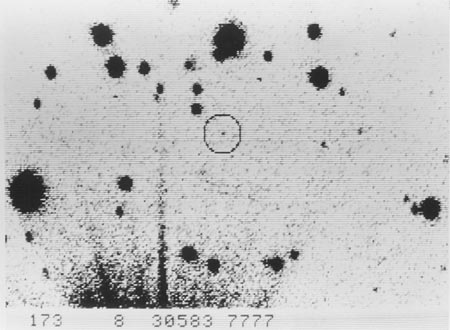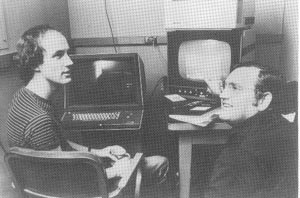HALLEY’S COMET
WATCH NEWSLETTER
VOLUME
2, NUMBER 1 – JANUARY, 1983
HALLEY’S
COMET RECOVERED OCTOBER 16, 1982

HALLEY’S COMET,
(circled), as detected by astronomers at the California Institute of Technology
on October 16, 1982. The astronomers
used an advanced electronic detector system and the 200-inch Hale telescope at
Palomar Observatory to make this premier observation of the comet on its
current approach to the sun. (Calif. Institute of Technology photo).
This
special edition of our NEWSLETTER was prompted by the early recovery (discovery
of sighting) of Halley’s Comet. On its
last return to the vicinity of Earth, Max Wolf at Heidelberg first discovered
it on September 11, 1909. This was just
a little over seven months before the comet’s perihelion (point closest to the
Sun) on April 20, 1910. Prior to its
recovery on September 16, 1982, Halley’s Comet was last seen on June 16, 1911,
a full fourteen months after perihelion.
As we noted in our earlier
newsletters, while early recovery was anticipated because of our modern
sophisticated technology, we were doubtful that it would be seen before late
1983. The October 16, 1982 recovery is
a full three years and four months before perihelion on February 9, 1986. This long period will give scientists and
astronomers valuable research time to explore the wonders of this most famous
of all comets. We are grateful to G.
Edward Danielson, one of Halley’s co-discoverers at Caltech, for personally
providing us with the pictures and news release. We are printing the news release in full as the Caltech News
Bureau in Pasadena submitted it to us.
THE ACTUAL
NEWS RELEASE:
Astronomers at the California
Institute of Technology have detected Halley’s comet, the object of a search by
astronomers worldwide, for the first time on its current approach to the
sun. The comet, which last sped through
the inner solar system in 1910, is the most famous object of its kind.

Caltech’s David C. Jewitt and G. Edward Danielson examine the image of Halley’s Comet they obtained on October 16, 1982. The discovery was the first detection of the comet on its current approach to the sun. (Calif. Institute of Technology photo).
The astronomers, led by graduate
student David C. Jewett and staff member G. Edward Danielson, first found the
comet on October 16, 1982 and re-verified their observations on October
19. They used the 200-inch Hale
Telescope at Caltech’s Palomar Observatory, the largest optical telescope in
the United States. The comet is located
in the constellation Canis Minor.
They found the comet using an advanced
electronic detector that was developed for the Space Telescope, to be launched
in 1986.
The discovery has been reported to the
International Astronomical Union in Cambridge, Massachusetts. Besides Jewitt and Danielson, also involved
in the effort to find the comet are James E. Gunn of Princeton University,
James A. Westphal, professor of planetary science at Caltech; research fellow
Donald P. Schneider; Alan Dressler of the Mount Wilson and Las Campanas
Observatories of the Carnegie Institution of Washington; and Caltech staff
member Barbara A. Zimmerman.
The comet was detected when it was
approximately 11 astronomical units (AU), or about a billion miles, from both
the earth and the sun. An AU is the
average distance between the earth and the sun, about 93 million miles. This would place it about 1.5 AU (140
million miles0 beyond the orbit of Saturn.
At present the comet is extremely
faint because it is not close enough to the sun for solar radiation to warm
it. When this happens, the comet will
begin spewing forth the volatile material within it, creating the
characteristic glowing head, or coma, and the brilliant tail. The comet is now roughly 50 million times
too faint to be detected with the naked eye.
It has a magnitude of 24.3 on the Thuan-Gunn magnitude scale used by the
astronomers. By comparison, the
faintest star visible to the naked eye is magnitude 6.
The detector used to find the comet is
known as PFUEI, for Prime Focus Universal Extragalactic Instrument. It was developed by Grimm and Westphal at
Caltech, and consists basically of an 800 by 800 unit array of supersensitive
electronic light detectors called a charge-coupled device, or CCD. These devices have proven far more sensitive
than the photographic plates traditionally used by astronomers to collect light
from the heavens. Combining the
200-inch-diameter mirror of the Hale telescope with modern television-type CCD
detectors enables astronomers to record faint images like that of comet Halley,
which would have been invisible with the same telescope only a decade ago.
The observations of Halley’s comet
were attempted on several nights and were interleaved with observations by Drs.
Dressler, Gunn, Schneider, and Schmidt, of quasars and clusters of galaxies at
the limits of the universe. Thus,
arriving at the telescope on October 16, 1982 was sunlight that bounced off
Halley’s comet 1 ˝ hours earlier and starlight that had been traveling from
distant galaxies for four billion years.
On the observing run, the telescope
was aimed at the region where the comet was expected to be, according to
predictions made by Donald Yeomans of Caltech’s Jet Propulsion Laboratory. The PFUEI was exposed to starlight for 480
seconds at a time, in frames approximately 10 to 15 minutes apart. On six frames taken on October 16, the comet
was detected, moving significantly from frame to frame was predicted. On October 19, the field was again observed,
and the comet had moved from where it was previously.
Halley’s comet was first identified by
Edmond Halley in 1695. Halley found
that the comet was similar to the orbit of comets that had approached the sun
in 1531 and 16-7. The comet has now
been identified in historical records dating back to 240 B.C.
Halley’s comet has a mass of about a
billion tons, and develops a tail many millions of miles long as it approaches
the sun. It moves in a highly
elliptical orbit that ranges between 0.6 and 35 AU. This means it travels from between the orbits of Mercury and
Venus to beyond the orbit of Neptune.
The comet returns to the sun once
every 76 years. On its next close
approach in February, 1986, the comet will be intensely studied by a number of
international space probes. Because comets are samples of the primitive solar
system, scientists hope to learn much about the origin of the sun and planets
by studying Halley’s comet.
Return to Halley's Comet Newsletter
Return to Halley's Comet Home Page
Return to Halley's Comet Home Page